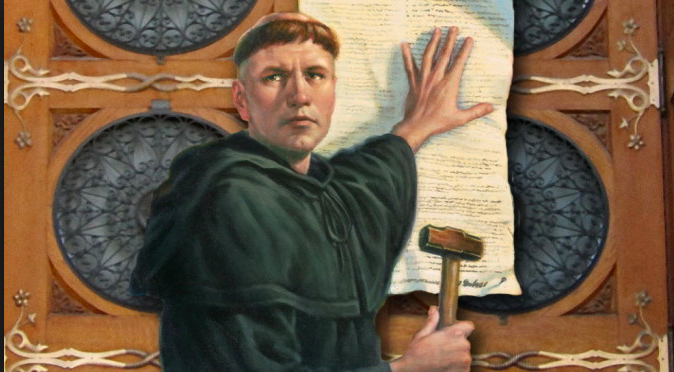November 3, 2017
Church History and Captain Obvious
When it comes to how we want our biblical and church history sometimes we fall victim to Captain Obvious.
So we kinda want this view of the crossing of The Red Sea:

We kinda want this view of Luther dramatically nailing his 95 theses to the door, his freshly tonsured head glistening in the golden shaft of light falling from above:

And we definitely want this view of the birth of Jesus (Why, hello shopping mall Christmas season):

The reality is that it was all a little more contested than that, a little less Captain Obvious.
We gloss over the fact Exodus 14 says a strong east wind sent by the Lord caused the sea to thin out overnight. In our desire for the truly spectacular we ignore the idea that it wouldn’t have taken all that much depth of water to drown an army dressed in military gear who ended up stuck in mud anyway. Exodus 15, the song of Miriam, leaves us in no doubt as to the origin of that act, but from an external perspective, outside the “interpreted- to-community”, (as opposed to the “interpretive community”) it could be, and probably was, contested. Although even there, the link to God’s work could still be made (see Rahab’s interpretation of the events in Joshua 2).
We ignore the inconvenient truths of the early chapters of Matthew and Luke where we read of a nativity that would have been somewhat strung out, somewhat mundane and that the events took place over a two year time period. Indeed we conflate the shepherd (not in Matthew’s Gospel), and wise men (not in Luke’s gospel), in order to ensure we’re not losing any of the drama – or should I say melo-drama of the event. It was certainly a contested interpretation in its day: What the Magi viewed as a promise from God was viewed as a threat by Herod, and indeed, all Jerusalem with him.
The point of the Bible is that it interprets events that could be otherwise interpreted. That are, until “men spake from God” to give the interpretation, contested events. Maddenly, frustratingly, there’s just not enough Captain Obvious in the Bible to make people have to believe by sight.
Hence we tend to forget that for huge swathes of biblical history the people of God lived lives just as we are called to – by faith -, and not by the sight of a huge body of water splitting down the middle. That’s why Hebrews 11 is a chapter about faith – faith among God’s people in the old covenant and the new.
It’s why I love the book of Ruth, for in it we see the providential hidden hand of God bringing about his purposes, creating the tapestry of the salvation story, but hiding the full picture. It’s only when the threads are pulled together at the end of the story that we start to see what’s going on:
Now these are the generations of Perez: Perez fathered Hezron, Hezron fathered Ram, Ram fathered Amminadab, Amminadab fathered Nahshon, Nahshon fathered Salmon, Salmon fathered Boaz, Boaz fathered Obed, Obed fathered Jesse, and Jesse fathered David. (Ruth 4:18-22)
It’s when that name “David” is shot across our bows that we see, finally, the “taa-dah” moment of God’s big picture salvation work that seems painfully absent up until that time. And even then only in retrospect of David’s life when the text was written. It’s as if God’s primary way of working in the world is in small, bite-sized normal chunks with ordinary, broken people who he providentially guides and uses to carry out his astonishing purposes. Fancy that.
And of course that’s most true of the cross. Even that was a contested event in the public square, until revelation from God delineates what it actually meant. Hence in Acts 4 after Peter and John heal the crippled man, their Jewish religious detractors make this statement:
What shall we do with these men? For that a notable sign has been performed through them is evident to all the inhabitants of Jerusalem, and we cannot deny it.
They could not deny the healing. What they could deny, however, was what that notable sign meant. How to interpret it. Would it not have been easier for Jesus to appear and do the sign himself? Prove to all of the people post resurrection that he was indeed the Christ? Indeed after Peter and John return from being interrogated about that healing, God’s people pray this:
“Sovereign Lord, who made the heaven and the earth and the sea and everything in them, who through the mouth of our father David, your servant, said by the Holy Spirit,
“‘Why did the Gentiles rage,
and the peoples plot in vain?
The kings of the earth set themselves,
and the rulers were gathered together,
against the Lord and against his Anointed’
for truly in this city there were gathered together against your holy servant Jesus, whom you anointed, both Herod and Pontius Pilate, along with the Gentiles and the peoples of Israel, to do whatever your hand and your plan had predestined to take place.
The same event is interpreted by two different sets of people in two completely different ways. What we get here, of course, is a recorded event that ends up as Scripture that is being interpreted contemporarily in the light of other Scripture.
And as for Luther? Well at least in the Scriptural accounts we’ve got an interpretative statement on the events. Now, in this era after the closure of the canon, we’re not going to get the “spake from God” bit. So we often risk doing a Captain Obvious in order to make our point.
Hence in this 500th anniversary year of The Reformation it’s probably easier to gild the lily a little, just in case someone doesn’t make the connections. It’s easier to make Luther look dramatic in a shaft of light than it is to admit he took the normal route many a monk had taken before him to discuss the issues of the day affecting the church.
We tend to make that day in 1517 appear like the glorious dawn, a bit more Hollywood and a little less Wittenberg. It’s a bit like painting a bigger smile on the Mona Lisa just to ensure everyone knows it is actually a smile.
We tend to compress and tighten up events much as the nativity scenes that will be played out in thousands of settings around the country compress and tighten up their events. And yet the irony is that the very compressing, the very colour saturation has the opposite effect to our intention.
Rather than make it seem more obviously true, this renders the event less obviously true, relegating it to Captain Obvious enactments that cannot stand the heat of historical or critical scrutiny (Take a bow Charlton Heston and Cecil B DeMille).
Yet the event that spawned the major shift in the last five hundred years of church history should be viewed much more like the book of Ruth than the Hollywood version of the parting of the sea or the Hallmark version of the nativity.
It should be viewed with a calm sense of how God works providentially through history; doing his best work behind the scenes. Bringing about his purposes in ways that are no less miraculous that the Captain Obvious moments we tend to cling to.
God’s sovereign omniscience allows him to bring the threads of millions of events together for his purposes and create the rich tapestry of salvation history, both those events that are interpreted by Scripture and those, what we would label the more profane, that are not.
The urgency of Luther’s theses; the first casual glance by Henry VIII towards Anne Boleyn; Gutenberg’s invention of the printing press; the rise of nationalism across Europe. Who alone but God could see those seemingly disparate threads coming together?
But come together they did, even though there’s nothing Captain Obvious about them at first glance. And He’s still working the threads of our lives and the church today into that rich tapestry that will one day be fully and finally revealed. That will one day be fully and finally interpreted on the day when he says to those who have called upon His name by faith and not sight; “Well done, good and faithful servant.”
Written by
There is no guarantee that Jesus will return in our desired timeframe. Yet we have no reason to be anxious, because even if the timeframe is not guaranteed, the outcome is! We don’t have to waste energy being anxious; we can put it to better use.
Stephen McAlpine – futureproof
Stay in the know
Receive content updates, new blog articles and upcoming events all to your inbox.


